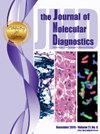Rapid, Reliable, and Interpretable Copy Number Variant Curation Visualizations for Diagnostic Settings with SeeNV
IF 3.4
3区 医学
Q1 PATHOLOGY
引用次数: 0
Abstract
Copy number variants (CNVs), structural alterations in the genome involving duplication or deletion of DNA segments, are implicated in various health conditions. Despite their clinical significance, accurate identification and interpretation of CNVs remain challenging, especially in the context of whole-exome sequencing (WES), which is commonly used in clinical diagnostic laboratories. Although WES offers economic advantages over whole-genome sequencing, it struggles with CNV detection because of technical noise introduced by laboratory and analytic processes. Manual curation of CNV calls generated by these tools is labor intensive and error prone. To address this, SeeNV, a command-line tool, is introduced to aid manual curation of CNVs at scale. SeeNV is one solution to these issues, developed in collaboration with and used by the Precision Diagnostics Laboratory at Children's Hospital Colorado. SeeNV generates static infographics for each CNV, incorporating sample and cohort sequencing coverage statistics, CNV population frequency, and, more, facilitating rapid and precise assessment. Using CNV calls identified in publicly available WES and whole-genome sequencing samples, users can rapidly and reliably curate CNV calls, needing only 4.3 seconds to curate a call, achieving 0.95 recall (analytical sensitivity) and 0.74 precision (positive predictive value). SeeNV is freely available for download on GitHub.
快速,可靠,可解释的CNV策展可视化与SeeNV诊断设置。
拷贝数变异(CNVs)是基因组中涉及DNA片段复制或缺失的结构改变,与各种健康状况有关。尽管具有临床意义,但准确识别和解释CNVs仍然具有挑战性,特别是在临床诊断实验室常用的全外显子组测序(WES)的背景下。虽然WES比全基因组测序(WGS)具有经济优势,但由于实验室和分析过程引入的技术噪声,它在CNV检测方面存在困难。这些工具生成的CNV调用的手动管理是劳动密集型的,而且容易出错。为了解决这个问题,引入了SeeNV,一个命令行工具,以帮助大规模手动管理cnv。SeeNV是与科罗拉多儿童医院精密诊断实验室合作开发并使用的一种解决方案。SeeNV为每个CNV生成静态信息图,包括样本和队列测序覆盖统计,CNV种群频率等,促进快速准确的评估。使用公开可用的WES和WGS样本中识别的CNV呼叫,用户可以快速可靠地管理CNV呼叫,只需4.3秒即可管理呼叫,实现0.95的召回率(分析灵敏度)和0.74的精度(阳性预测值)。SeeNV可以在GitHub上免费下载。
本文章由计算机程序翻译,如有差异,请以英文原文为准。
求助全文
约1分钟内获得全文
求助全文
来源期刊
CiteScore
8.10
自引率
2.40%
发文量
143
审稿时长
43 days
期刊介绍:
The Journal of Molecular Diagnostics, the official publication of the Association for Molecular Pathology (AMP), co-owned by the American Society for Investigative Pathology (ASIP), seeks to publish high quality original papers on scientific advances in the translation and validation of molecular discoveries in medicine into the clinical diagnostic setting, and the description and application of technological advances in the field of molecular diagnostic medicine. The editors welcome for review articles that contain: novel discoveries or clinicopathologic correlations including studies in oncology, infectious diseases, inherited diseases, predisposition to disease, clinical informatics, or the description of polymorphisms linked to disease states or normal variations; the application of diagnostic methodologies in clinical trials; or the development of new or improved molecular methods which may be applied to diagnosis or monitoring of disease or disease predisposition.

 求助内容:
求助内容: 应助结果提醒方式:
应助结果提醒方式:


